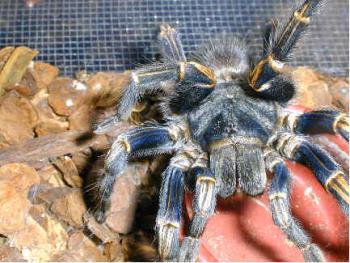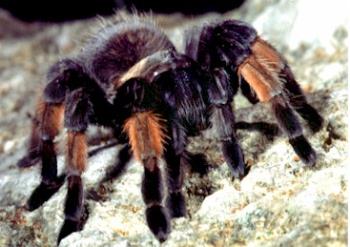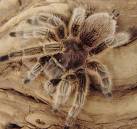How to feed Tarantulas?
By jasjon
@jasjon (252)
Philippines
December 17, 2006 7:50pm CST
The most commonly used tarantula food is store-bought crickets. These are fine, but a variety of diet is good too. If you catch insects for your spider, make sure they haven't been exposed to pesticides, and avoid some earwigs and certain beetles (earwigs and some beetles can be dangerous or even poisonous). Larger tarantulas will often eat baby mice, and many tarantulas will take dead prey, or even pieces of meat -- you can experiment. Drosophila (fruit flies) are good for small spider lings, but a mixed diet is safest. Tarantulas will stop feeding when preparing to molt and food must be removed.
1 person likes this
25 responses
@telesca (184)
• Italy
18 Dec 06
Beeeeeehhhhhhhhhh.......
I hate tarantulas!They're so horrible, hairy, big, venemous...
But, for feed a tarantula, I found them:
Care for tarantulas is relatively easy: Feed them every few days or once every 1-3 weeks, keep humidity high in the cage (if a tropical species), and make sure that there are no crickets in the cage when the spider moults or else the cricket will kill the spider. Crickets or flies are better than mealworms or superworms. Don't let their cages dry out. Give them water. Your spiders do not need large cages and smaller animals will do better in smaller containers than larger ones. Keep them on a sterile substrate soil (vermiculite, commercial top soil, pet bark [not cedar], peat - NOT soil from your yard!) which can hold moisture. Provide retreats and some environmental enrichment (bark to climb on, something to hide under). Plants are for your aesthetics, not for the spiders. No sharp cactuses or other plants that can injure the spider.
@mashimaro (1094)
• Philippines
18 Dec 06
Tarantulas eat most any insects. They fare well enough on crickets, but it’s always a good idea to vary their diet. Give them some mealworms, king mealworms, or an occasional roach to expand their menu. No animal thrives on a single food. Change their food occasionally. Forget most caterpillars. Oddly enough, many Tarantulas learn to eat goldfish.
Keep a small water dish in their cages. Tarantulas expire very quickly when kept without water. (Forget that nonsense about them living in the desert.) Putting a little blob of aquarium filter floss in the container lets them rest on top and drink their water at leisure. The new desert-oriented water dishes look very good in Tarantula houses.
@muntaha (376)
• Bangladesh
18 Dec 06
True tarantulas are spiders belonging to the family Theraphosidae (Greek for thera "wild animal, beast" + phos "light"). Certain members may also be known as bird spiders, monkey spiders, baboon spiders or rain spiders. They are characterized by having tarsi (feet) with two claws and claw tufts, called scopulae. Related families include the funnel-web spiders and the trap door spiders, which sometimes are also called tarantulas. The family Theraphosidae includes over 800 different species of tarantulas, divided over 12 subfamilies (formerly 13) and 113 genera.
Like other spiders, tarantulas have to shed their exoskeleton periodically in order to grow, a process called molting. Young tarantulas may do this several times a year, while full grown specimens will only molt once every year or so, or sooner in order to replace lost limbs or lost urticating hairs.
Tarantulas may live for many years--most species taking 2 to 5 years to reach adulthood, but some species may take up to 10 years to reach full maturity. Upon reaching adulthood, males typically have but a 1 to 1.5 year period left to live and will immediately go in search of a female with which to mate. It is rare that upon reaching adulthood the male tarantula will molt again.
The habit of male spiders wandering in search of mates makes them especially visible. In late summer and early autumn (September and October in the northern hemisphere), the males will leave their hiding places and walk about, hoping to encounter the hiding place of a female with which to mate. They are willing to cross roads and trails in this quest, and that is when they are most likely to be observed.
When the mature male encounters the burrow of a female, he will draw the female out and signal his intentions to mate by vibrating his body and tapping his front legs. If the female is receptive to mating, she will also vibrate and tap her legs. After mating, the male must get away quickly, or it is possible that he will be eaten. A female tarantula who is unreceptive to mating may also eat the male if he attempts to mate. This result, however, is less common among tarantulas than other spiders. Certain species of tarantulas have been known to mate multiple times over the course of several weeks.
Since females will continue to molt after reaching maturity, they are able to regenerate lost limbs and increase their lifespan. Female specimens have been known to reach 30 years of age and even 40 years, and have survived on water alone for up to 2.5 years. If well cared for, females can expect to live 20-30 years and males 10-12 years, depending on the species.
@friends4ever (116)
• India
18 Dec 06
We feed all tarantulas on crickets, we always ensure that the cricket is smaller than the spider, but not so small that the spider can't capture it, Sometimes they should be fed with a locust or a pink mouse, all food that is not taken with in 24 hours, should be removed, if your spider stops feeding, don't worry, tarantulas can go many months without feeding, more often than not, there is a good reason for your tarantulas fasting, we feed our tarantulas 3 or 4 crickets, once or twice a week, most good pet shops will stock crickets and frozen mice, if not they should order them for you.
@nabzicool (2)
• India
18 Dec 06
take a small spoon fill it with the required food feed that tare....tera........wat ever it is
@unisis (1673)
• Indonesia
18 Dec 06
For adult tarantulas should be fed a varied diet of live crickets (medium sized or smaller), waxworms, superworms, and mealworms. Remember that only arboreal species can get off the ground, and you can also offer them fruit flies or moths. Offer food twice a week, as much as your spider will eat, and remove uneaten food after a day. Don't be concerned if your spider stops eating. If this happens, offer a different type of food at the same schedule, removing uneaten food. Spiders often stop feeding, and it usually indicates an upcoming molt (see Health). It is also very important that all of your food is acquired from a dealer of live pet foods. Insects caught in your yard may carry traces of pesticide that can kill your spider.
The main health concern with tarantulas is the molting process. Tarantulas molt yearly as they become older (more often in young spiderlings). If your tarantula stops feeding, becomes darker in appearance, or seems to lose hair, you can suspect a molt soon. Humidity should be raised slightly, and stress minimized. It is likely your spider will not eat for up to a week after the molt is completed, so stop offering food.
@blacknight000 (1397)
• Philippines
18 Dec 06
No idea at all!...I dont have enough time to feed that kid of spider!...its very poisonous!...I dont think they are advisable to be a pet!...Just leavce them to a forest for them to find there own food and survive!..They need to be at a forest for them to expand there species!..























